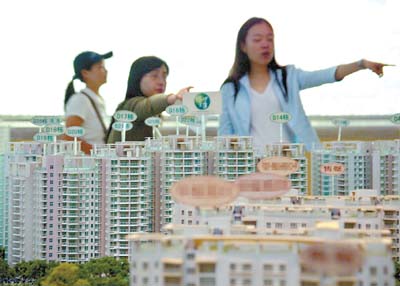11. 1993: Setting the goal of restructuring the financial sector
On December 25, 1993, the State Council made the decision on reforming the country's financial system.
The key objectives of the reform: To set up a macro control system of the Central Bank to independently implement monetary policy under the leadership of the State Council; to set up a institutional framework with state-owned commercial banks as its main body and coexisting with various types of financial organization, separating policy finance from commercial finance; to set up a unified, open, orderly competitive financial market system under strict management; to establish the status of the People's Bank of China as the central bank to independently implement monetary policies; and to unify the official and market exchange rate from 1994.
In 1995, the Third Session of the 8th National People's Congress passed the Law on the People's Bank of China. Since December 1, 1996, China has realized free RMB convertibility in current accounts.
12. 1994: Starting the comprehensive reform on foreign trade sector
On January 11, 1994, the State Council made the Decision on Further Deepening the Reform of Foreign Trade System, setting following objectives: to unify foreign trade polices, decentralize foreign trade rights, facilitate equal competition, encourage independent operation of enterprises to assume sole responsibility for their profits or losses, combine industries and trades, promote a agent mechanism and to set up an operation system which adapts to international economic rules.
On April 1, 1996, China largely cut tariffs on over 4,000 commodities imports. The general tariff level reduced to 23%.
 |
House price keeps rising after reform was introduced into housing sector in the early 1990s. |
13. 1992, 1994: The medical and housing sectors respectively roll out reforming plans
In 1985, against the backdrop of China's reform and opening up, the medical and health sector launched its reforms. The core of the reforms concentrated on giving hospitals more decision-making power. The government decided not to provide money support to public hospitals. To make up for the inadequacy of government input, hospitals were allowed to raise the prices of medicines by 15%.
In 1992 China abolished the system under which governments covered more than 90 percent of medical expenses. In September that year, the Ministry of Health mandated that hospitals should subsidize or increase their incomes by running small factories or through subsidiary productions.
In 2000, the reform was gradually deepened, involving more issues concerning the system and the structure. In March 2000, the General Office of the State Council Administrative Office forwarded the 14 Guiding Opinions on Urban Medical System Reform submitted by eight ministries and commissions. In May 2001, the State Council General Office forwarded the Guiding Opinions on Rural Medical System Reform. During the process, there were escalating disputes and puzzles in regard to medical reform. With the decline of government investment in total medical expenses, reduced to only 15.2% by 2002, and the medical expenses mainly coming from local government finance, calls on property right reforms and the withdrawal of the state fund and the entry of private fund increased. By the end 2004, nearly 10 billion yuan fund from private and foreign enterprises entered into the restructuring endeavor of some 100 hospitals around the county. By 2005, the total market value of China's medical industry reached 640 billion yuan.
On July 18, 1994, the State Council made the Decision on Deepening Urban Housing System Reform, which clearly defined the basic content of urban housing system reform. It included changing the distribution method, distributing money instead of real houses according to employees' work performance as their welfare and to set up the public housing fund system. The issue of the Decision initiated the commercialization of urban houses, indicating the establishment of China's all-around housing market reform. The biggest significance of the Decision is that it has steadily promoted the sales of state-owned houses, gradually completed the privatization of housing in China by selling former state-owned houses to urban employees.
On July 3, 1998, the State Council issued the Notice on Further Deepening Urban Housing System Reform and Speeding up the Housing Construction, which abolished the house distribution system, clearing the barrier for developing commercial houses and making the commercial houses the main body of the market. On August 12, 2003, the State Council issued the Notice on Promoting the Sustainable and Healthy Development of the Real Estate Market. On August 7, the State Council issued Several Opinions on Solving the Housing Difficulty of Urban Low Income Families, for the first time it clearly indicated replacing economic housing with low-cost rental housing as the center of the housing guarantee system.
14. 1995: Putting forward the goal of "Two Fundamental Changes"
From September 25 to 28, 1995, the 5th Plenary Session of the 14th CPC Central Committee was held. The Session passed the Suggestions of the CPC Central Committee on Formulating the 9th Five-year Plan for National Economic and Social Development and the Goals of 2010. The Suggestions set forth that the key to realizing the 9th Five-year Plan and the Goals of 2010 was to carry two fundamental changes: the first was that the economic system would transfer from a traditional planned economic system to socialist market economic system; the second was that the economic growth method would be changed from an extensive to an intensive type. This key policy was an urgent and important strategic task addressing the whole situation of national economy, indicating that China's economic construction will move forward toward further system reform and quality improvement.
15. 1996: The foreign exchange management system achieves significant development
On December 1, 1996, China started to accept Article 8 of the International Monetary Fund Agreement, implementing the free RMB convertibility in current account. This indicated that China's foreign exchange management system reform had achieved significant development.